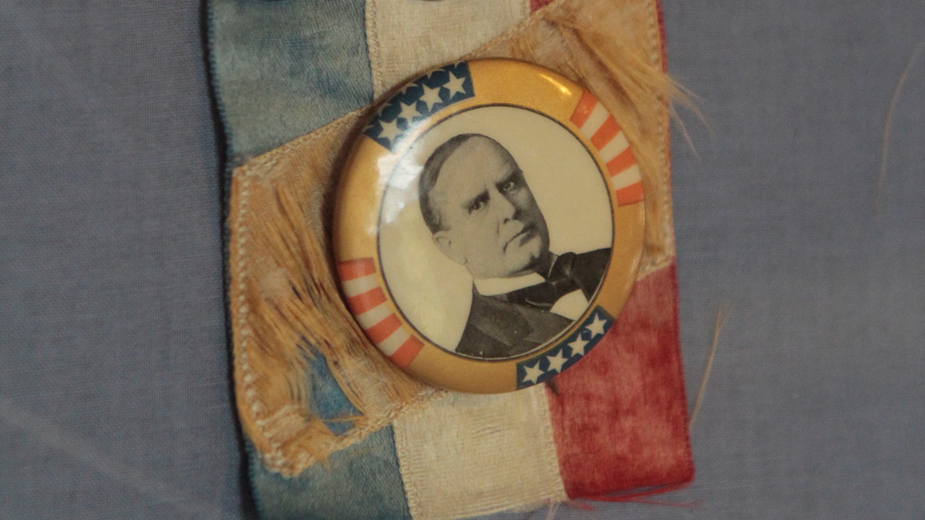Flashback: McKinley’s Presidential Campaigns Pioneered Buttons
NILES, Ohio – Gazing through the protective glass at the more than century-old McKinley campaign buttons, it’s easy to miss their significance. After all, political buttons that feature the faces of candidates and their campaign slogans have been ubiquitous in American politics.
These buttons, however, were a novelty to the supporters of the Republican standard bearer in 1896, William McKinley.
“This was the first campaign where they made real use of campaign buttons,” says Trish Scarmuzzi, curator of collections at the National McKinley Birthplace Memorial Museum in Niles, which celebrates its centennial this year.
The museum has a large collection of political buttons from McKinley’s presidential campaigns in 1896 and 1900. The Whitehead & Hoag Co. of Newark, N.J, patented pin-back celluloid buttons in 1896, just in time for McKinley’s first presidential campaign, which used mass-produced political buttons to rally support for the Republican nominee.
Political buttons proved ideal in using symbols to communicate with voters. “Most people could read, but sometimes the reading wasn’t so easy for them,” Scarmuzzi says. An image of McKinley on a gold background communicated his support for the gold standard, and images from the Civil War reminded voters that McKinley was a Union veteran.
Other buttons used simple slogans to communicate the candidate’s positions: “The Full Dinner Bucket” told them of McKinley’s support for the working man during the 1900 campaign and “Sound Money Club” promoted his fiscal policies.
McKinley’s Democratic opponent in 1896 and 1900, William Jennings Bryan, eventually followed suit and produced buttons with the slogan “Solid Silver,” advertising his support for an expanded money supply.
“They started using them as an advertising medium,” Scarmuzzi says. “In those days you didn’t see your candidate very much, so you just had that pin.”

Trish Scarmuzzi is the curator of collections at the 100-year-old McKinley museum.
Some buttons at the museum feature images of McKinley and Garret Hobart, his vice president who died in office in 1899.The dual portrait button is referred to as a “jugate,” and they continue in modern presidential elections.
Memorial buttons were produced to express the nation’s sorrow after McKinley’s assassination in 1901. Many of the buttons are attached to black ribbons.
The museum has other political campaign memorabilia that may seem odd to contemporary audiences. A “Soap Baby,” distributed as a campaign novelty item, is a baby doll made of soap with an accompanying tag that reads: “My papa will vote for McKinley.” Women did not vote in presidential elections until 1920.
The museum has other sundry items from McKinley’s campaigns: an umbrella decorated with the visages of McKinley and Hobart and a straight razor with the images of the president and his wife, Ida.
Also on display are two pipes with a depiction of McKinley’s head in place of the bowls of the pipes. “In those days, they tried to make your campaign memorabilia as useful as possible, Scarmuzzi says.
Artifacts and memorabilia in the museum help patrons understand the area’s connection to history, says Marcelle Wilson, an adjunct professor of history at Youngstown State University. “It’s memorabilia that helps people remember our place, not only here locally, but also nationally,” she says.
The memorial museum, which celebrates its centennial this year, was inspired by Joseph Butler Jr., a Mahoning Valley industrialist and lifelong friend of McKinley.
Butler raised funds for the museum from many of the leading industrialists of the day, including Andrew Carnegie, George Westinghouse and Andrew W. Mellon, later secretary of the treasury under presidents Warren G. Harding, Calvin Coolidge and Herbert Hoover.
The industrialists and others donated more than $1,000 each to the project. A bronze bust of each was placed in the outdoor assembly space; they surround a statue of McKinley.
Birthplace Memorial will re-enact the dedication ceremony of 1917, with actor Mike Wilson portraying President William Howard Taft and an appearance by Dorothy Butler, a great-granddaughter of Joseph Butler Jr.
Pictured at top: This campaign button advertises the endorsement of William McKinley by a fraternal group formed in 1890, Commercial Travelers of America, that provided insurance.
Copyright 2024 The Business Journal, Youngstown, Ohio.



